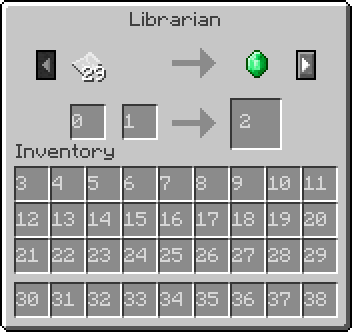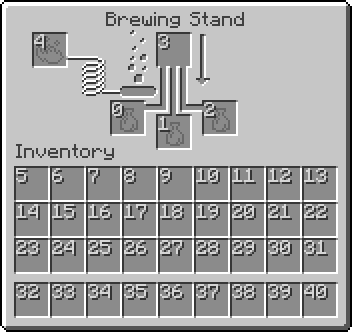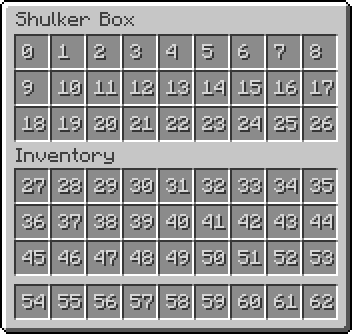Minecraft Inventory Slot Numbers
Blackjack is the most popular table casino game while online slots are the popular casino game amongst the video machines. Both games have high odds and are tons of Inventory Slot Numbers Minecraft fun.
- Minecraft Inventory Slot Numbers
- Minecraft Inventory Slot Numbers For Pc
- Minecraft Player Inventory Slot Numbers
- Minecraft Inventory Slot Numbers
A GUI is an in-game screen with which has interactive objects. It consists of text fields, images, buttons, slots etc.
- A brewing stand 's bottom slots are numbered 0 to 2 from left to right, its top slot is 3 and the fuel slot is 4. A furnace 's slots are numbered 0 for the input slot, 1 for the fuel slot, and 2 for the output slot. Other blocks which hold items but don't have inventory GUIs (flower pots and jukeboxes) can only be changed with / data.
- Anyone know the ID of the Helmet slot in the normal Inventory?
- Is it possible to test for the amount of a specific item in a players inventory in the latest snapshots? For example I need to see if a player has 2 arrows in his inventory so a separate command block stops giving them more.
GUI Properties
There are 5 properties:
- GUI Width: The width of your GUI (in pixels)
- GUI Height: The height of your GUI (in pixels)
- GUI Type: 2 options: With Slots or WIthout Slots. If you select With Slots, you will be able to create slots (Input and output slots) and inventories.
- Render background layer: Check this box if you want a backgound (Grey-White color). If not, uncheck the box.
- Bind GUI to block: If you want to make a Tile Entity, you have to choose the block with the option for inventory activated.
GUI Components
There are 6 components:
- Buttons: The buttons are objects with events. This event works like the normal events.
- Images: Just images from your PC.
- Text Label: Plain text that supports MCreator's default tags for some variables (both in-game and global MCreator's variables). The text can also be colored.
- Text Input: A section where the player can write any text and can be detected and used to execute events, example uses are like a custom command block or search function.
- Input Slot: Description below
- Output Slot: Description below
Slots and Inventory Components
To create a slot (input or output) you must first enable inventory, with the Inventory Option:
Slots Options

It has 2 buttons: Input and Output Slot:
- Input Slot: Choose it if you want to put items in there.
- Output Slot: Choose it if you want to put items with events, not by hand.
Input slot
- Belongs to: Select the inventory that you created earlier.
- Slot ID: It is the ID of this specific slot. It's necessary to don't have the same number more than one time.
- Custom Color: If you want to put a color in the slot, select the color. If not, skip clicking this button.
- Limit stack input: If you want to limit the type of item that the slot accepts (Like a redstone dust or a torch), select the desired item. If not, just ignore this option.
- Add Event: It's just self-explanatory.
Finally, just move the slot where you want it to be
Output Slot
- Belongs to: Select the inventory that you created earlier.
- Slot ID: It is the ID of this specific slot. It's necessary to don't have the same number more than one time.
- Custom Color: If you want to put a color in the slot, select the color. If not, skip clicking this button.
- Add Event: It's just self-explanatory.
Putting items in Output Slots
- Add an Event (In blocks, items, guns, slots, etc.)
- Select: Place items in GUI slot
- Write the ID of your Output slot (visible on the GUI, it's a number like 02)
- Write the name of the Inventory of your Output slot
- Select the item that you want to put in and select the amount.
Edit Options
These buttons will help you make a GUI:
- Move Component: Moves the components you select.
- Remove Component: Removes selected component.
- Remove Inventory: Removes selected inventory.
- Snap components on the grid: Toggles grid used to easily align components.
Minecraft displays the player inventory differently, according to how the window was opened. Ranges of slot indices vary in meaning between different “windows”. The Open Window packet indicates which window is being opened according to:
- 2Chest
| Window Type | Description |
|---|---|
| minecraft:container | Fallback for unknown types; also used for Ender chests. Behaves the same as minecraft:chest. |
| minecraft:chest | Chest, large chest, or minecart with chest |
| minecraft:crafting_table | Crafting table |
| minecraft:furnace | Furnace |
| minecraft:dispenser | Dispenser |
| minecraft:enchanting_table | Enchantment table |
| minecraft:brewing_stand | Brewing stand |
| minecraft:villager | Villager |
| minecraft:beacon | Beacon |
| minecraft:anvil | Anvil |
| minecraft:hopper | Hopper or minecart with hopper |
| minecraft:dropper | Dropper |
| minecraft:shulker_box | Shulker box |
| EntityHorse | Horse, donkey, mule or Llama |
The slot number is calculated starting at 0, counting up through the window's unique slots, and then counting through the players inventory.
For all windows, the slot in the upper-left corner of the player's inventory is slot n where n is the number of unique slots, and slot number -999 is always used for clicking outside the window.
The number of unique slots in the window is sent in the Open Window (Play, 0x2d, clientbound) packet for all storage windows (e.g. Chest, Dropper). For non-storage windows (the items get dropped when the window is closed, e.g. Workbench, Anvil), the received number of unique slots is always 0, but it can be looked up by the client from the window type.
The default inventory window, which is never explicitly opened by the server, has 10 unique slots.
Rectangular regions are always indexed starting with the upper-left corner and scanning across rows. If a window has a crafting region, the output slot is always slot 0 followed immediately by the input region.
Each window type is described in the following sections. All slot index ranges are inclusive and reflect the indices observed in the Minecraft protocol.
For the window properties (additional data in each window, e.g. smelting progress or enchantments), refer to the table in the Window Property packet.
Using -1 as slot index and as window id will set the cursor item (the stack dragged with the mouse).
Player Inventory
This is the inventory window that the player can always open, typically by pressing E since Beta 1.4. Before, you had to press I.
| Slot range | Description |
|---|---|
| 0 | crafting output |
| 1–4 | 2×2 crafting input (1 + x + 2 * y) |
| 5–8 | armor (head, chest, legs, feet) |
| 9–35 | main inventory |
| 36–44 | hotbar |
| 45 | Offhand slot |
Note that this is different from inventory items stored in a player.dat file. This may help: https://gist.github.com/459a1691c3dd751db160
Chest
This is the window that is opened when the player right-clicks on a single chest block.

| Slot range | Description |
|---|---|
| 0–26 | chest |
| 27–53 | main inventory |
| 54–62 | hotbar |
Large chest
This is the window that is opened when the player right-clicks on a double chest block (two adjacent chest blocks).
| Slot range | Description |
|---|---|
| 0–53 | chest |
| 54–80 | main inventory |
| 81–89 | hotbar |

It is possible to receive different 'Number Of Slots' parameters than those two. In vanilla, using /setblock four times around a chest and then opening the middle chest will open a window with 5*27 chest slots. Some custom servers will send chest inventories with other sizes, usually ranging from 1 row to 6 rows. These may be used for custom GUIs. It is thus important to correctly use the 'Number Of Slots' parameter in the open window packet to determine the number of rows in the chest, rather than hardcoding what constitutes a regular chest or a large chest.
Crafting table
This is the window that is opened when the player right-clicks on a workbench.
| Slot range | Description |
|---|---|
| 0 | crafting output |
| 1–9 | 3×3 crafting input (1 + x + 3 * y) |
| 10–36 | main inventory |
| 37–45 | hotbar |
If the 'Number Of Slots' parameter is not set to 0, the opened window will behave like a container window.
Furnace
The window that appears when a furnace is right-clicked.
| Slot range | Description |
|---|---|
| 0 | ingredient |
| 1 | fuel |
| 2 | output |
| 3–29 | main inventory |
| 30–38 | hotbar |
If the 'Number Of Slots' parameter is inferior to 3, placing an item in a slot may crash the client.
Dispenser
The inventory that appears when a dispenser or dropper is opened.
| Slot range | Description |
|---|---|
| 0–8 | 3×3 dispenser contents (x + 3 * y) |
| 9–35 | main inventory |
| 36-44 | hotbar |
If the 'Number Of Slots' parameter is inferior to 9, placing an item in a slot may crash the client.
Enchantment Table
The inventory of an enchantment table. The enchant buttons trigger a Enchant item packet.
Minecraft Inventory Slot Numbers
| Slot range | Description |
|---|---|
| 0 | item to enchant |
| 1 | lapis lazuli slot |
| 2–28 | main inventory |
| 29–37 | hotbar |
Brewing stand

The GUI that appears when a brewing stand is opened.
| Slot range | Description |
|---|---|
| 0-2 | bottles/potions |
| 3 | potion ingredient |
| 4 | blaze powder |
| 5-31 | main inventory |
| 32-40 | hotbar |
Villager trading
The GUI that appears when a villager is right-clicked. Note that if the villager only requires one item, you can put it in either (or both) slots.
| Slot range | Description |
|---|---|
| 0-1 | input items |
| 2 | result |
| 3–29 | main inventory |
| 30–38 | hotbar |
Beacon
The window that appears when a beacon is right-clicked.
Minecraft Inventory Slot Numbers For Pc
| Slot range | Description |
|---|---|
| 0 | payment item |
| 1–27 | main inventory |
| 28–36 | hotbar |
Anvil

| Slot range | Description |
|---|---|
| 0 | first item |
| 1 | second item |
| 2 | result |
| 3–29 | main inventory |
| 30–38 | hotbar |
Hopper
Minecraft Player Inventory Slot Numbers
The window that appears when a hopper or hopper minecart is opened.
| Slot range | Description |
|---|---|
| 0-4 | hopper slots |
| 5–31 | main inventory |
| 32–40 | hotbar |
Shulker box
This is the window that is opened when the player right-clicks on a shulker box chest.
| Slot range | Description |
|---|---|
| 0–26 | box slots |
| 27–53 | main inventory |
| 54–62 | hotbar |
Llama
The inventory that appears when a tamed llama is right-clicked and has a chest, or when the player's inventory is opened while riding a tamed llama. Depending on the value of the strength field, the number of chest rows may vary (max is 5, so 15 slots).
There still is a saddle slot, even though it cannot be used and is invisible.
Slot positions within the llama inventory vary - slot 2 may be at (1,0) or at (0,1) depending on the number of columns.
| Slot range | Description |
|---|---|
| 0 | saddle |
| 1 | carpet |
| 2-(2+3*Strength) | llama inventory |
| (2+3*Strength)+1-(2+3*Strength)+27 | player inventory |
| (2+3*Strength)+28-(2+3*Strength)+35 | hotbar |
Unchested llama
Llama with strength 1
Llama with strength 2
Llama with strength 3
Llama with strength 4
Llama with strength 5
Horse
The window for when a tamed horse is right-clicked or the player's inventory is opened while riding a horse.
| Slot range | Description |
|---|---|
| 0 | saddle |
| 1 | armor |
| 2–28 | main inventory |
| 29–37 | hotbar |
Horse slots
Skeleton horse slots
Zombie horse slots
Donkey
Minecraft Inventory Slot Numbers
The inventory that appears when a tamed donkey (or mule?) is right-clicked, or when the player's inventory is opened while riding a tamed donkey or mule.
There still is an armor slot, even though it cannot be used and is invisible.
| Slot range | Description |
|---|---|
| 0 | saddle |
| 1 | armor |
| 2–16 | donkey inventory |
| 17–43 (2-28 if unchested) | player inventory |
| 44–52 (29-37 if unchested) | hotbar |
Unchested donkey
Chested donkey
Unchested mule
Chested mule